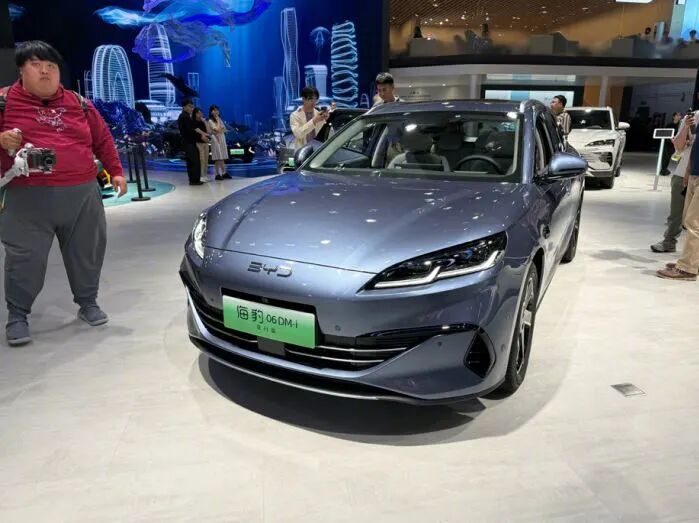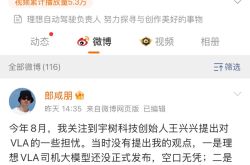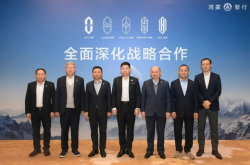Auto Companies Place Bets on PHEV/REEV: A Genuine Trend or a Deceptive Trap?
![]() 10/14 2025
10/14 2025
![]() 609
609
With the swift advancement of the new energy vehicle market, the proportion of traditional fuel vehicles is set to keep declining. The growth of the pure electric vehicle market will decelerate, while the market share of plug-in hybrid electric vehicles (PHEVs) and extended-range electric vehicles (REEVs) is anticipated to continue its upward trajectory.
Propelled by global sustainable development goals, the automotive industry is undergoing a transformation of unprecedented scale, particularly within the realm of new energy vehicle powertrain technology. In recent times, new energy powertrain technologies, encompassing battery electric vehicles (BEVs), PHEVs, and REEVs, have witnessed robust growth in the Chinese market. This growth has not only reshaped the competitive landscape of the automotive industry but also exerted a profound influence on the upstream and downstream industrial chains.
Differentiated Landscape in the Powertrain 'Main Battleground'
In this transformative process that is reshaping the industrial landscape, the competition for new energy powertrains is far from evenly distributed. The selection of the 'main battleground' and the emergence of a differentiated landscape are intricately linked to the performance of China, the global core automotive market. In 2024, China's annual production and sales of new energy vehicles surpassed 10 million units for the first time, securing the top global ranking for ten consecutive years. This achievement not only underscores the consumption potential of the Chinese market but also highlights China's industrial advantages in the new energy vehicle sector.
In China, the new energy vehicle powertrain market is further segmented, especially in the sedan segment, where PHEVs and REEVs exhibit distinct competitive dynamics. According to S&P Global Mobility's automotive analysis data, in the sedan market, PHEVs dominate the mid-to-low-end segments owing to their first-mover advantage and economies of scale. For instance, PHEV models like the BYD Qin PLUS DM-i have achieved cost control and market scale effects through a 1.5L plug-in solution in the low-end market segment (ranging from 4.7m to 4.85m), successfully attracting budget-conscious consumers and capturing the majority of the market share in this segment. In contrast, REEVs encounter certain product competitiveness challenges in the mid-size sedan market due to the need to sacrifice pure electric range to control costs.
In the E-segment market, there are currently relatively few mainstream PHEV and REEV models, partly due to the higher proportion of pure electric vehicles in this segment. From a cost perspective, since PHEVs require larger engines, REEVs may hold an advantage in this area. For example, REEV models like the Leapmotor C01 Extended Range and the Dongfeng eπ007 can be priced equally to or even lower than similarly sized PHEVs, offering consumers a more cost-effective choice.
The SUV market, another crucial segment, shares many similarities with the sedan market in terms of the competitive landscape between PHEVs and REEVs but also displays unique differences due to vehicle characteristics. In the low-end market segment (ranging from 4.7m to 4.85m), plug-in SUVs dominate due to significant cost advantages and economies of scale, with models like the Changan UNI-V iDD and BYD Song Pro DM-i performing outstandingly. In contrast, REEVs face dual challenges of range and cost control in this segment. In the mid-to-large and large SUV market (5m and above), REEVs demonstrate strong competitiveness, with intelligent and mid-to-high-end extended-range product series like the AITO M9 and Li Auto L9 achieving excellent market performance since 2024.
Considering the performance in both the sedan and SUV markets, S&P Global Mobility provides a clear judgment: the D&E segments will become the future main battlegrounds for PHEVs and REEVs. Although PHEVs entered these segments earlier and have formed scale advantages, as the REEV market expands and cost-reduction strategies are implemented, their product competitiveness will gradually improve. Additionally, in the E-segment and above, REEVs can better meet the transitional needs of family users during the electrification transition, while PHEVs can leverage their advantages in handling, sportiness, and off-road capabilities to penetrate these segments.
The 'Batons' and Compliance Challenges in the New Energy Race
Apart from the market's inherent competitive landscape, policy plays a pivotal role as the 'baton' determining the market direction of PHEVs and REEVs. For example, trade-in subsidy policies effectively stimulate consumption and activate the market, particularly promoting the small and micro car segments. Purchase tax subsidy policies influence the timing and choices of consumers, significantly impacting the supply-demand relationship and sales rhythm in the new energy vehicle market.
While incentive policies primarily provide short-term market stimulation, regulatory policies set the key tone for the long-term development of China's new energy powertrains. Among these, the dual credit policy, emission regulations, and fuel consumption regulations have particularly profound impacts.
Among various regulations, the dual credit policy is undoubtedly a significant driver promoting the transition to green and efficient powertrains. Under the dual credit framework, new energy vehicle models and low fuel consumption models receive clear policy preferences. The dual assessment mechanism of new energy vehicle credits and fuel consumption credits compels companies to increase their investments in new energy and energy-saving technologies.
Unlike the dual credit policy, which covers all new energy sectors, emission regulations have a more focused impact on internal combustion engine vehicle models and exhibit significant differences in their effects on the commercial and passenger vehicle markets. Due to the substantial increase in after-treatment costs, these regulations have a greater impact on the diesel-dominated commercial vehicle market. Commercial vehicle companies need to invest more in technological upgrades and equipment modifications to meet emission standards. For the passenger vehicle market, although the impact is relatively smaller, with the upgrade from China VI to China VII emission standards, passenger vehicles also require corresponding technological improvements.
In this process, companies need to balance resource allocation, weighing whether to continue investing significant time and money in developing different types of engines or to streamline their product portfolios and concentrate resources on developing more promising models and engines. Currently, some companies have begun reducing their investments in traditional internal combustion engine research and development and are instead increasing their investments in new energy powertrains or low fuel consumption engines to adapt to market changes and regulatory requirements.
In addition to emission regulations, the upgrade of fuel consumption regulations also has a profound impact on powertrain development. In particular, a key adjustment in the Phase VI fuel consumption regulations directly alters the application windows for different new energy technologies. S&P Global Mobility analysis points out that, in terms of actual performance, BEVs have a combined fuel consumption (converting electricity consumption to fuel consumption) of approximately 1.5-2.0L/100km, significantly lower than the 2030 regulatory standards, giving them a clear advantage in meeting regulatory requirements and providing ample space for further development. REEV models perform at around 2.5-3.5L/100km, also meeting regulatory requirements and receiving policy support for their sustained market development. PHEVs have a wider distribution, with performance after conversion ranging from approximately 2.5-4L/100km. Based on currently available models, about 20% of PHEV models may not meet the 2030 compliance emission reduction requirements.
Furthermore, some companies consider directly replacing internal combustion engine (ICE) components with BEVs, but this strategy faces challenges related to the growth rate of the BEV market and product expansion. Although the BEV market is developing rapidly, its performance in the mid-to-large vehicle segments is generally average. Moreover, if core issues such as charging infrastructure, battery prices, and driving range cannot be quickly addressed, companies choosing to massively shift to BEVs at the current juncture will face risks.
Shanghai Auto Show Unveils Technological Breakthrough Routes for PHEV/REEV
Driven by both policy guidance and market exploration, the technological routes of PHEVs and REEVs are continuously evolving and upgrading. The 2025 Shanghai International Auto Show, as an industry benchmark, precisely showcases the latest technological breakthrough achievements of both.
S&P Global Mobility conducted a comprehensive analysis of 35 new PHEV/REEV models at the 2025 Shanghai Auto Show, with PHEV models accounting for approximately two-thirds of the total. This data not only confirms their current mainstream market status but also reflects the diversified development trend of PHEV products.
The analysis results indicate that PHEV products are diversifying. PHEV models from BYD and Wuling, known for their affordable prices, good fuel economy, and practicality, meet the daily travel needs of a broad range of ordinary consumers and have a wide user base in the mid-to-low-end market. Meanwhile, automakers like Geely and Chery have started introducing PHEV products in the mid-to-large SUV segment, showcasing the upward expansion trend of the PHEV market.

Unlike the diversified layout of PHEVs, REEV products at the Shanghai Auto Show have a more focused positioning, while the active participation of joint venture brands has also injected new variables into the REEV market. In terms of model types and market positioning, REEV products primarily target the flagship high-end SUV market, being positioned as high-end and flagship models by automakers. Additionally, some original equipment manufacturers (OEMs) have started developing REEV sedan products, mainly concentrated in the large flagship sedan segment.
Besides the conventional sedan and SUV markets, the large off-road SUV segment has also become an important area for PHEVs and REEVs to showcase their advantages. This choice is driven by the special performance requirements of off-road scenarios for vehicles. In the large off-road SUV segment, OEMs generally prefer PHEV and REEV products due to the specific demands of off-road scenarios for vehicle power performance, range capabilities, and reliability.
Beyond vehicle layout, the powertrain strategies showcased by major OEMs at the Shanghai Auto Show more clearly outline the development trajectory and future direction of PHEV and REEV technologies.
The adjustment of powertrain strategies is first reflected in the optimization of engine lineups. With the popularization of new energy vehicle models, the reliance on traditional engines has decreased, leading to a large-scale simplification of engine lineups in the industry in 2024. While simplifying engine lineups, OEMs have not ceased their technological exploration, especially in the field of downsized engines. Several companies have showcased new engine models specifically designed for extended-range products, demonstrating their forward-looking technological reserves. Additionally, to support Chinese brands in breaking through to the mid-to-high-end market, multiple companies have exhibited 2.0T engines targeting the PHEV and REEV markets at the auto show, aiming to enhance product performance and positioning. Notably, some automakers have further explored differentiated powertrain layouts to meet the diverse needs of consumers. A new configuration strategy has emerged, where a single model offers multiple engine options combined with various motor and battery configurations to achieve refined product coverage.
The 'Upward Breakthrough' and 'Global Journey' of PHEV and REEV
Technological iterations and product upgrades in the domestic market have laid the foundation for PHEVs and REEVs to embark on an 'upward breakthrough' journey. With the acceleration of globalization efforts by Chinese automotive companies, both are also embracing a 'global journey' to enter international markets, presenting both opportunities and challenges.
Specifically, PHEVs are leveraging their long-accumulated price advantages in the globalization process while gradually breaking through previous market limitations and exploring new growth spaces through platform integration and brand elevation. In the future, OEMs will consider upgrading PHEV products using internal combustion engine (ICE) platforms, developing dedicated hybrid powertrains, and highlighting their 'low fuel consumption' advantages. Brand elevation has also brought new market spaces for PHEVs. Previously, PHEVs were mainly concentrated in the economic market segment below RMB 150,000 and D-segment vehicles. With technological maturity and upgrading consumer demands, some companies have started introducing PHEV products in the mid-to-large SUV and sedan segments.
Platform integration is another significant opportunity for PHEV development. As the PHEV market continues to expand, companies have begun optimizing their platforms and developing PHEV-first platforms. Such platforms can better integrate core components like batteries, motors, and engines, incorporate the latest generation of intelligent features, achieve system optimization, and enhance overall performance and competitiveness.
Currently, REEV products primarily appear in the high-end market of large SUVs and sedans with a 'new luxury' image. Since REEVs are often developed based on BEV platforms, they can achieve functions such as long range, 800V fast charging, and advanced electronic/electrical architecture configurations. Therefore, S&P Global Mobility believes that more companies will leverage dedicated BEV platform resources in the future, combining the demand characteristics of the Chinese market, and shift from a BEV-only strategy to a parallel BEV+REEV strategy.
Meanwhile, the market for Range-Extended Electric Vehicles (REEVs) has also drawn the interest of joint ventures and foreign brands. At present, these entities rely on domestic brand resources to craft regional products tailored to local markets. Take BMW and Volkswagen as examples; they have collaborated with their domestic partners to jointly develop REEV models, striving to carve out a niche in China's high-end new energy vehicle market. Looking ahead, if REEVs can overcome challenges related to cost control and spatial layout when applied to small and compact vehicles, they hold the potential to be promoted as global solutions.
S&P Global Mobility holds the view that both the cost-effectiveness advantage of Plug-in Hybrid Electric Vehicles (PHEVs) and the high-end technological features of REEVs endow Chinese automotive companies with unique competitiveness when venturing into overseas markets.
For instance, in the European market, traditional European automakers are currently grappling with a multitude of challenges during their transition to Battery Electric Vehicles (BEVs). The exorbitant transition costs have placed significant financial strain on these companies. Moreover, the charging infrastructure is far from perfect, with an uneven distribution and an insufficient number of charging stations, which has impeded the widespread adoption of BEVs. Consumer acceptance of BEVs also requires improvement, as issues like range anxiety and lengthy charging times remain major concerns for consumers when considering purchasing BEVs. These factors have collectively resulted in a slower-than-anticipated growth rate of BEVs in the European market. Chinese companies can capitalize on this market demand by introducing PHEV and REEV products to the European market through collaborations with European firms and by engaging in consumer education and guidance initiatives. Alternatively, they can adopt a proactive approach by leveraging their product advantages to enter the European market ahead of competitors and seize market opportunities.
In contrast to the "transitional demand" in the European market, in non-strictly regulated markets such as Thailand and Brazil, Chinese automotive companies encounter fierce competition from both local and global rivals. In these markets, PHEVs were not mainstream products in the past, and consumer awareness and acceptance of them remain relatively low. To succeed in these markets, Chinese companies need to precisely position their products, gain a deep understanding of the demand characteristics, consumption habits, and usage scenarios of local consumers, and integrate their technological strengths to develop products that cater to local market needs.
Overall, with the rapid development of the new energy vehicle market, the market shares of PHEVs and REEVs are projected to continue expanding. Of course, PHEVs and REEVs also face certain challenges in their development, such as breakthroughs in battery technology, enhancement of the charging infrastructure, and further cost reduction. Only by addressing these issues can PHEVs and REEVs gain a more significant edge in future market competition and achieve sustainable development.
Note: This article was first published in the "Industry Report" column of the September 2025 issue of "Auto Review" magazine. Please stay tuned for more updates.
Image: From the Internet
Article: Auto Review
Layout: Auto Review




